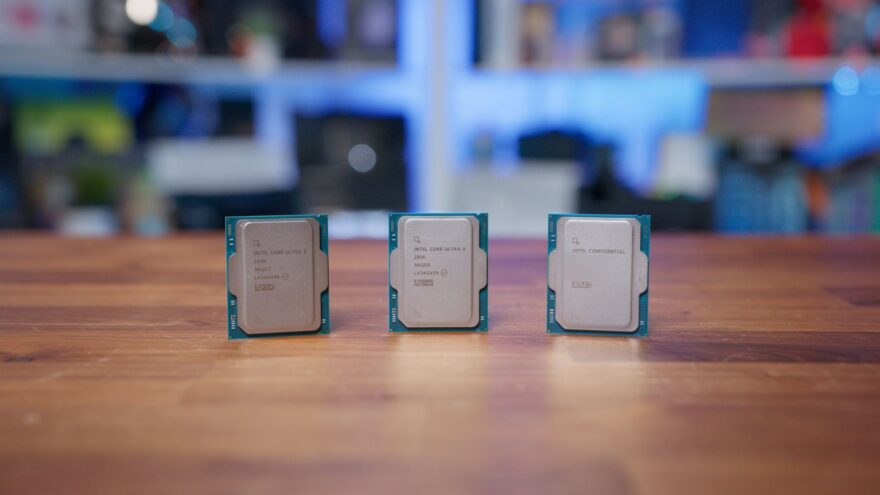Intel Core Ultra 5 245K CPU Review

The Intel Core Ultra 5 245K is here, and for those looking for a mid-to-high-end desktop gaming CPU, it’s certainly going to have a lot of appeal. As part of Intel’s new “Arrow Lake” series, this chip boasts a hybrid architecture with 14 cores (6 Performance-cores + 8 Efficient-cores) with 20 threads. Intel are promising an upgrade in terms of multi-core performance compared to its predecessors, although the key focus of the new CPUs is massive improvements to efficiency and thermal performance.
One of the most exciting aspects of the Core Ultra 5 245K is its integrated Intel Arc Xe2 Graphics (64EU). This significantly upgraded iGPU is expected to deliver a considerable boost in graphical performance, potentially allowing for smooth 1080p
gaming without the need for a dGPU, However, this also allows the CPU to take up some more of the slack of daily tasks, allowing for lower overall system power usage.
Of course, there are a few new CPUs launching in this series, and we have reviews of the Intel Core Ultra 7 and the flagship Intel Core Ultra 9. For most home users and gamers, a Core Ultra 5 will likely be more than enough, albeit, we’ll be putting that to the test in this review. The Core Ultra 7 will likely appeal more to enthusiast gamers and the Core Ultra 9 will appeal to content creators wanting to improve rendering tasks and other demanding applications.

Specifications
- Cores: 14 (6 performance-cores and 8 efficient-cores)
- Cache: 24 MB Intel Smart Cache
- Clock Speed: Up to 5.20 GHz
- Power:
- 125 W Processor Base Power
- 159 W Maximum Turbo Power
- Graphics: Integrated Intel UHD Graphics with 4 Xe-cores
- AI: Intel AI Boost
- Memory: Support for up to 192 GB of DDR5 6400 MT/s memory
- Socket: FCLGA1851 socket

Intel Core Ultra Series

Intel’s Core Ultra CPUs are here at last, marking a big change in the Intel naming structure, albeit not a particularly slick one. These are technically the 15th Gen Intel Core CPUs, but they’re the first generation of the new Intel Core Ultra series! These processors codenamed “Arrow Lake-s” mark the debut of Intel’s new nomenclature, replacing the familiar “i” series with the “Ultra” branding. This change signifies more than just a name update; it reflects a fundamental change in architecture and focus, a new starting point for future generations of CPUs, with the first gen having a significant focus on thermal performance and power efficiency for Intel to build upon.
AI and Beyond

One of the most prominent features of the Core Ultra series is its emphasis on artificial intelligence (AI). These CPUs are the first to feature a dedicated Neural Processing Unit (NPU), a specialized hardware component designed to accelerate AI tasks. This allows for significant performance gains in AI-powered applications, ranging from content creation and gaming to productivity and security. Intel claims that the Core Ultra CPUs deliver up to 50% faster performance in AI-enabled creator applications compared to competing processors.
Intel has been investing in their ARC discrete GPU technology, and are now wanting to bring this to their desktop processors, replacing the UHD graphics that we saw on Raptor Lake refresh processors. Consider those as Intel’s XE low-power architecture, whereas now, we have Xe high-performance gaming architecture, or HPG for short. This should assist in more graphically intensive applications including gaming, content creation, AI, and video encoding with features like QuickSync.
Power Consumption and TDP

The new architecture features a hybrid design of performance cores (P-cores) and efficient cores (E-cores), similar to what we’ve seen on previous CPUs, which can deliver up to 14% faster multi-threaded performance compared to the previous generation. Additionally, Intel has achieved a 40% reduction in package power, which is great news, as the previous gens were notoriously power-hungry and had lofty cooling requirements. The Core Ultra series also introduces a new platform and socket (LGA1851), requiring users to upgrade their motherboards to accommodate these CPUs, which is why today we also have a series of new motherboard reviews for you to read.








